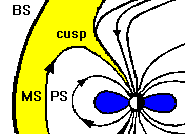 Cusp
Cusp
spaceweb@oulu.fi - last update: 21 December 1998, 1500 UT (RR)

Introduction
The magnetic field lines of the Earth
can be divided into two parts according to their location on the sunward or tailward side
of the planet.
Between these two parts on both hemispheres are funnel-shaped areas with near zero
magnetic field magnetitude called the polar cusps.
They provide a direct entry for the magnetosheath
plasma into the magnetosphere
(e.g., Reiff et al., 1977; Marklund et al., 1990; Yamauchi et al., 1996).
The high-altitude cusp, which is often called the
exterior cusp, can be considered to be a part of the magnetospheric
boundary layer system.
It is connected to the low altitude cusp or cusp proper, as some like to
call it. The low-altitude cusp can be defined as follows:
The low-altitude cusp is the dayside region in which the entry of
magnetosheath
plasma to low altitudes is most direct. Entry into a region is considered more
direct if more particles make it in (the number flux is higher) and if such
particles maintain more of their original energy spectral characteristics.
Measurements have shown, that the cusp is highly confined region,
extending about 2.5 hours in local time, but only about one degree or less
in latitude. However, because of the strong dependence of the cusp
position on IMF conditions, the statistical studies tend to show somewhat
larger cusp regions.
Phenomena
The magnetosheath plasma penetrating into the low-altitude cusp (and the
surrounding low-altitude boundary layer regions) is responsible for , e.g.,
part of the dayside auroral precipitation.
However, recent measurements by the Polar satellite have shown that also
ions in the MeV range are present (Chen et al., 1997, 1998). These events
have been called as cusp energetic particle (CEP) events.
It is natural that, in addition to plasma, many types of
waves and turbulent flows have also access to the
ionosphere via the cusp. These include
- solar wind variations
- including those generated in the foreshock upstream of the bow shock
- radiation from the parallel and perpendicular shocks
- magnetosheath turbulence and waves
- magnetopause boundary variations due to, e.g.,
- flux-transfer events
- pressure variations
- Kelvin-Helmholtz instability
- waves and particle variations which take place in the boundary layers just
inside the magnetopause.
The low-altitude cusp is the focus of these phenomena and ground
observations are comprised of their superposition.
References
- Chen, J., T. A. Fritz, R. B. Sheldon, H. E. Spence, W. N. Spjeldvik, J. F. Fennell,
and S. Livi, A new temporarily confined population in the polar cap during the
August 27, 1996 geomagnetic field distortion period, Geophys. Res. Lett., 24,
1447, 1997.
- Chen, J., T. A. Fritz, R. B. Sheldon, H. E. Spence, W. N. Spjeldvik, J. F. Fennell,
S. Livi, C. T. Russell, J. S. Pickett, and D. A. Gurnett, Cusp energetic particle
events: Implications for a major acceleration region of the magnetosphere,
J. Geophys. Res., 103, 69-78, 1998.
- Lockwood, M., and M. F. Smith, Low and middle altitude cusp particle
signatures for general magnetopause reconnection rate variations: 1. Theory,
J. Geophys. Res., 99, 8531-8553, 1994.
- Marklund, G. T., L. G. Blomberg, C.-G. Fälthammar, R. E. Erlandson,
and T. A. Potemra, Signatures of the high-altitude polar cusp and dayside
auroral regions as seen by the Viking electric field experiment,
J. Geophys. Res., 95, 5767-5780, 1990.
- Reiff, P. H., T. W. Hill, and J. L. Burch, Solar wind plasma injection
at the dayside magnetospheric cusp, J. Geophys. Res., 82, 479, 1977.
- Yamauchi, M., H. Nilsson, L. Eliasson, O. Norberg, M. Boehm, J. H. Clemmons,
R. P. Lepping, L. Blomberg, S.-I. Ohtani, T. Yamamoto, T. Mukai, T. Terasawa,
and S. Kokubun, Dynamic response of the cusp morphology to the solar wind:
A case study during passage of the solar wind plasma cloud on February 21, 1994,
J. Geophys. Res., 101, 24675-24687, 1996.
See also:
 Cusp
Cusp Cusp
Cusp